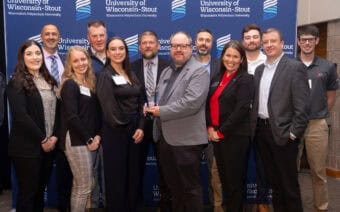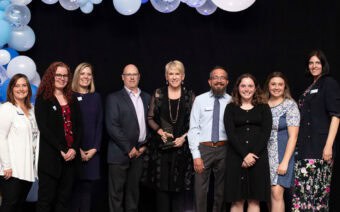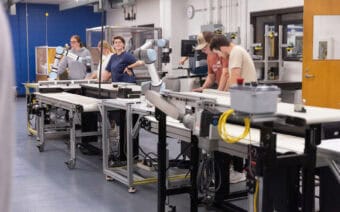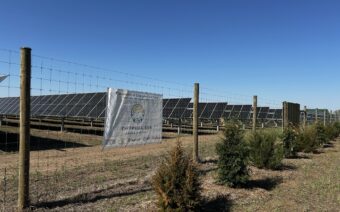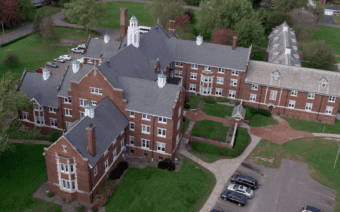
May 27, 2024
LA CROSSE – In recent years, the conversation around sustainable and renewable energy has become increasingly popular – in businesses, in educational institutions and at home.
Solar panels are one example of a renewable source of energy.
But, when there’s cloudy weather, or – especially in Wisconsin – there are shorter days and longer nights during the winter, the sun isn’t always a reliable energy source.
The same can be said for wind turbines on the days the air is still.
This, Sujat Sen, assistant professor of chemistry at the University of Wisconsin-La Crosse (UWL), said is exactly why he, along with his undergraduate students, have been researching additional and more sustainable sources of energy – specifically through electrochemistry.
And thanks to a five-year, $556,579 Faculty Early Career Development (CAREER) grant from the National Science Foundation (NSF), Sen said they will be able to take their research further.
“I’m honored and humbled to get this award,” he said. “It is usually a difficult grant to get at a primarily undergraduate institution… I’m grateful that NSF saw the potential for this kind of work being done.”
Over the next five years, Sen said the grant will fund three areas of focus when it comes to looking at renewable energy sources – a research component, a teaching component and a high school component.
Electrochemistry and energy
Some may be asking: what is electrochemistry – and how can it tie in with renewable energy?
Electrochemistry, Sen said, is the combination of electricity and chemistry: “How does electricity interact with chemicals, and how do you use chemicals to create electricity?”
For example, “A solar cell has some chemicals inside, and it converts the sunlight it receives to create electricity,” he said.
Another example of an electrochemical device is electricity being used to create chemicals, as can be seen with the example of chlorine production.

“Essentially, we take electricity from whatever source we can get and use it to create chemicals, and then convert, for example, sodium chloride (salt) into chlorine using electricity as an energy source,” he said.
And, though already-established renewable sources – such as the previously mentioned solar panels – use electrochemistry to generate energy, Sen said he believes “the answer to our challenges in energy production is not going to be solved by a single source.”
“I don’t think solar energy is going to be the answer for everything,” he said. “Nor will wind energy be the answer for everything. Ultimately, I think what we need is a balance of multiple sources, and I think that’s where the challenge is. It’s not just one technology we need to focus on, but rather multiple.”
Sen said coal, oil and natural gas will continue to be part of the energy solution “for decades to come,” alongside more renewable sources like solar, wind and geothermal.
But, he said more research with electrochemistry – especially along the lines of batteries – needs to start right now, since those “technologies don’t exist yet for large scale applications.”
And, for those already-established green technologies to be more dependable, Sen said, they need energy to either be stored or converted, which is where electrochemistry comes in.
“When I say batteries, I’m not talking about cell phone batteries or laptop batteries,” he said. “I’m talking about giant batteries that can power an entire building, power an entire city, potentially.”
When it comes to chemicals, Sen said you can’t take the same ones inside phones, for example, “and just make larger versions of it.”
“It doesn’t work like that,” he said. “It has to be different types of chemistry, different types of chemicals that can be scaled to an extent that can power (something much larger). That’s where we need more research into this technology.”
Sen said that journey starts with educating the younger generation.
High school involvement
Sen said one of the most important aspects of the CAREER grant is informing and recruiting high school students.
The assistant professor said for year three of the grant, he plans to organize a workshop for area high school students.

Students, he said, would come on campus and spend a week learning about electrochemical devices and their relation to renewable energy.
The primary goal of the workshop, Sen said, is to “get them excited about this area of chemistry.”
“I think one of the things NSF is excited about, and I’m most excited about, is trying to make it more accessible at an earlier age,” he said. “Because electrochemistry as a discipline is typically (taught) at the graduate school level.”
In undergraduate curriculum, there may be one week of class dedicated to electrochemistry, but in high school, Sen said, it usually isn’t covered.
And though there is a lot of funding to work toward more renewable energy efforts, he said his goal is to provide the skillset to do the necessary research.
“(I want to) empower students to take up these types of industrial jobs that require electrochemistry but don’t necessarily require a PhD,” he said.
One of his former students who now works for a battery recycling company in Nevada, Sen said, is a great example of having robust knowledge of electrochemistry without the PhD title.
“He did a summer of research with me, he took my class and knew that was enough electrochemistry (knowledge) for this battery company to hire him as a research technician,” he said.
Undergrad, research
Sen said he will also use a portion of the grant to focus on his electrochemistry and renewable energy research at UWL, as well as teaching more of his students about it.
The research side, he said, is more fundamental and involves using nanofluids – fluid that contains nanometer-sized particles.
The nanofluids, he said, can be used to speed up the chemical energy conversion process.
“I’m trying to develop some ideas on battery technology, as well as electrolyzer technology using nanofluids,” he said.

Sen said he will continue to develop the electrochemistry and renewable energy curriculum in the classes he teaches at UWL, which are:
- Chemistry of Materials
- Instrumental Chemistry
- General Chemistry
For example, in CHM322: Chemistry of Materials, Sen’s upper-level course, he said his students assemble and test devices in the lab for solar cells, fuel cells, electrolyzers and batteries.
The grant, he said, will allow him to develop computer simulations of the devices.
“The advantage of doing that is now students can explore it in the lab setting, but they can also go home and play with a computer simulation of the same device,” he said. “That has advantages because you’re not limited by the lab time – it’s only a three-hour lab, (and) there’s only so much you can do in the lab.”
Using a computer simulation of the device, he said, is also safer.
“In a simulation, you can push the limits of the battery,” he said. “For example, you can try charging the battery in three minutes as opposed to two hours and see how that affects the performance of the battery. Say you’re charging your cell phone, and you try to charge it in two minutes, what will that result in?”
To learn more, visit uwlax.edu.
 Family Roots Greenhouse – rooted in family, friends and plants
Family Roots Greenhouse – rooted in family, friends and plants The Charmant Hotel in La Crosse awarded a MICHELIN Key
The Charmant Hotel in La Crosse awarded a MICHELIN Key


